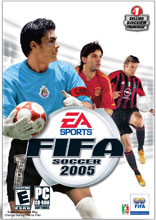The latest installment in EA’s long-running FIFA series is just a matter of days away. Their release always cause great waves of soccer expectation, especially in almost every country outside of the USA, seeing as though, with baseball, football, hockey, and basketball, there’s little room left for another sport. But now, finally, the USA is catching on to the worldwide soccer fever that EA’s FIFA series is (partly) responsible for. The continual success of FIFA games lies, not only in the fact that they are technically superb and crammed with licensed players, leagues and stadiums (simulation heaven), but also in the perennial familiarity they bring with them. Players know what to expect from the FIFA series – seasonal tweaks across the pitch, but no major changes to basic gameplay or technical and simulation aspects. When you start playing a FIFA game you immediately know it’s a FIFA game, even if the last one you played was on the N64, or even the SNES. Gameplay has always been basically the same, or at least it’s had the same feel. It seem that this time around, though, gameplay was EA’s main focus for change. Visual technical advancements mean that we all recognize and acknowledge which player is Ronaldo and which is David Beckham, but now it’s time to see if they actually play like their real-life counterparts.
Again, FIFA’s graphics and sound are top quality; indeed, they seem to get better each year. Player models, stadiums, and crowds look, move and sound like the real deal, although convincing and authentic, there’s not a substantial difference from the 2004 version. However, as I mentioned in the previous paragraph, it’s the gameplay that’s changed on FIFA 2005.
One of the main recurrent problems with gameplay in EA’s FIFA series has been that there’s never too much room for team playing; you have to rely too heavily on personal plays in order to score. It’s almost as if you have only three or four participating players and all the others are merely obstacles for your opponent (or even for you sometimes). Soccer is a team sport, and often more deeply than other sports out there. Soccer fans will tend to agree that one of the most important aspects for winning (and for the sheer spectacle) in soccer is space; making space to shoot the ball, to pass, to execute a header, and close spaces down to avoid your opponent from doing the same things to you. One of the most effective ways of doing this is by making one-touch passes, due to their unpredictability these types of passes often open spaces through a rival’s defense. EA has tweaked the one-touch system for FIFA 2005, but don’t think that you get it easy now – the game’s AI is still very tight. Just try the demo of the game: you can choose either Arsenal FC (a very offensively minded team) or A.C. Milan (a very defensive team). Play with Arsenal and try to score a goal on Milan’s defense – it’s tough as hell! One-touch passing helps you create spaces, but overusing it can cause a lot of lost balls and broken plays, just as in real life. However, the demo version of FIFA 2005 isn’t really enough of an experience to get a convincing idea of how deeply gameplay has changed; other teams are necessary for a fair comparison and an objective judgment.
Things are looking good where the simulation aspect of FIFA 2005 is concerned. Breaking through A.C. Milan’s defense is as hard as it should be, and you’ll need to use variable strategic approaches if you truly expect to emerge fruitful from the encounter. It’s not particularly enjoyable to be relentlessly repelled by your opponents, but trying to crack a tough defense is still challenging and fun, which makes scoring a goal an even more satisfying experience. That’s how soccer is, though, it’s not always as open ended and free flowing as the pitch might make you think; sometimes those 100+ meters aren’t enough against certain rivals. Simulation and the FIFA series go hand-in-hand, and 2005 is looking to be no different, which is especially good news for long-time fans of the franchise. A new addition that will prove to be a good move from EA is the Mexican Soccer League. Mexico is one of the biggest soccer countries in the world (fan-wise, of course). North American sales will surely rise as a consequence, at least in Mexico.
Mexico, Europe, Asia, and the whole world in general, await FIFA 2005’s imminent release with soccer-soaked anticipation as that magical date creeps inexorably closer!
